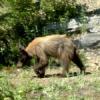I have not read all the posts up to this point but I think it is difficult to calculate pounds of material because the caloric density per gram can vary greatly. We also can't measure metabolic rate with Sasquatches necessarily as what you eat at what time can change the rate itself. In mammals the metabolic rate is effected by sun exposure, temperature, stress and sleep. Sasquatches do not seem to be pot-bellied ( fermentation gut adapted ) and seem to consume a lot of direct protein when compared to gorillas.
I would say that they focus on nutrient dense food heavily in the fall and again in the spring, sources heavily would lean toward insects, small critters, nuts, tubers, salmon, ungulates, fruits, lichens, mushrooms and softer plant leaf material. Just a side note, I am very convinced that omegas are likely the most important need to the Sasquatch, big brains demand them and this would explain the continued historic references in native cultures that sasquatch can become fairly confrontational in situations such as pulling salmon nets and invading smoke houses. I have also noted that Sasquatch reports do often happen on a regular basis close to large tracts of masting nut trees.
I suspect they target certain foods at certain times and try to conserve energy, the few long trackways on record seem to indicate very focused directional travel as if they have a point B in mind. If I had to guess with what little I know from reading, behavior and looking for feeding sites I would say someplace between 7500 to 1000 calories split between 30% fat, 30% carbs, and 40% protein averaged across the year cycle. That is my 2 cents and again I don't have a whole lot of confidence yet in my view here but it is where I am at, critics are welcome.
It would be interesting to see what the metabolic consumption of the Chinese snub nosed monkey is throughout the year as a comparison as they have a wide range diet and endure some fairly cold conditions following the snowline.



